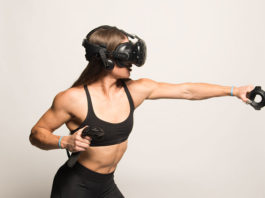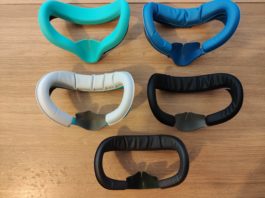Tips and tricks for the high flying platformer.
Windlands 2 is still one of the best first-person platformers you can play on Oculus, Vive and SteamVR headsets. While the best moments always come about when you’re swinging from tree to tree, you might find yourself lost at certain points in the game. Additionally, you might enjoy a few tips on how to burn extra calories while playing. Here is my short list of tips and tricks to give you a leg up in Windlands 2.
Gameplay Tips:
Pull Yourself Towards Your Next Swing
Windlands 2 features a unique grappling hook swinging mechanic, adapted from the original title Windlands, that lets you shoot hooks (out of either hand) at designated surfaces across the game world.
As such, when swinging, you can reach your destination faster by tugging or pulling on your grappling hook(s). Aggressive tugs propel you in the direction you’re tugging quite fast, and you can use the momentum to go further than you regularly would. There are some segments of the campaign, particularly in the Mountain area, where this trick is necessary to proceed.
Also, note that pulling yourself into your swings engages your arms (albeit very slightly, unless you’re wearing weighted gear as detailed further below), which helps you burn a few more calories while playing.

Deploy Long Ropes to Swing Farther
Swinging from tree to tree is hard work. Sometimes you might lose momentum and get stuck mid-air. Or you may need to make a much longer swing than is permissible with the (shorter) default grappling hook length. That’s where the rope extension ability comes in.
You can deploy longer ropes while swinging by holding the lower face buttons (A and X) on your Oculus Touch controllers or their equivalent on the Vive Wands/whichever controllers you’re playing with.
When you want to rev up your momentum again after getting stuck between swings, just fully extend your grappling hook(s) so that you’re hanging at the bottom of the long rope, and then let go of the button that extends them. Your ropes will recede back to regular length, pulling you forward (or upward) in the direction of the surface you’re hooked to.
Use Hangtime Between Swings to Shoot Enemies
It’s necessary to shoot enemies while mid-air in order to complete Windlands 2. This is because almost every boss battle past the first one (the giant robot spider), which you fight on the ground, is designed to keep you swinging from point to point.
However, you’ll probably spend about 30 minutes to an hour stumbling around and figuring out how to get a grip with the game’s controls anyhow. Instead of learning how to shoot your bow mid-air on the spot during one of those compulsory boss fights, I recommend that you practice this technique on some of the earliest enemies that you encounter.
Otherwise, watch YouTuber ‘Cheru’ struggle to learn basic gameplay mechanics so that you don’t have to:
https://youtu.be/KBhpcc80Rd0
Use Objective Markers if You Get Lost
It’s deceptively easy to get lost in the vertical playhouse that is Windlands 2. I found myself swinging in circles for at least an hour, practically ignoring the geographical signs telling me “This is where you go next!”. Unfortunately, the game is quite linear, and all that swinging can get monotonous if you aren’t moving from objective to objective.
Which is why you should definitely not do what I did, and instead try to follow the objective markers that developer Psytec has laid out for us poor souls.
Fitness Tips:
Weighted Gear
If you’ve been paying attention to what I talk about here at VR Fitness Insider, you may have noticed a trend. Yes, lovely reader, I recommend weighted gear for basically every game I write about—and, well, that’s not about to change.
Here’s my recommendation: Get yourself a weighted vest (about 10-15% of your total body weight for starters, then 16-25% once you’re truly comfortable with additional weight), and if you’re feeling particularly adventurous, a set of ankle weights and wrist weights—not exceeding three lbs per weight. Start at about one lb per weight, and move up slowly. Don’t wear a weighted vest for longer than an hour, and don’t wear ankle/wrist weights for longer than 10 minutes.
To reiterate why we’re always going on about weighted gear, it really just comes down to Windlands 2 being a stationary game—where you stand in one place for a long time without encountering any physical resistance. Weighted vests add resistance to your chest, shoulders, back, and core muscles. Meanwhile, wrist weights add resistance to your arms and ankle weights add resistance to your legs.
All weighted gear increases your baseline heart rate BPM (beats per minute) by a relative number of beats, forcing you to take in more air and burn more calories. While it can be dangerous to overuse weighted gear (I wrote about that here), the clear fitness benefits of wearing weights while standing and playing in VR are always worth pointing out.
Run in Place
There’s enough running around, in addition to jumping and swinging, that you could get some additional calorie burn from running in place while you play. With weighted gear on, running in place is a pretty good way to get your heartbeat up when playing games that are not normally designated as fitness games. If you want to feel more immersed in Windlands 2, this is also certainly a way to do it.
Watch this video to get a good feel for how you should run in place while playing a VR game:
Notice that she isn’t using any explosive movements here. Her knees are kept low. Basically, you don’t want to use high knees in VR because it’s easy to trick yourself into moving out of the center of your play area. You also don’t want to exhaust yourself. Instead, always try to keep your movement as steady as you can—similar to how the woman in the video does it.
Natural Locomotion
If you’re running in place, you’ll likely want something that tells the game to run along with you. Using analog sticks and thumbpads while running in place is passable, but it doesn’t feel natural. That’s why you should hop onto Steam and purchase Natural Locomotion at its MSRP of $9.99.
Natural Locomotion is the quintessential locomotion tool that I’ve heavily advocated for when it comes to physically moving around explorable VR titles on PC. The way NaLo works is, as you move your arms back and forth (which happens naturally when you run in place), it translates the signals coming from your controllers as movement inside of the game. It’s quite neat, and it’s highly customizable too. Check it out.
Eating Tips
It’s not the fun, juicy part of fitness in VR but it’s pretty much compulsory to take eating habits into account when talking fitness. I still wouldn’t consider myself the healthiest eater, but the basic global assumptions about healthy eating still apply here. Stay hydrated at all times, pay attention to your calorie intake, don’t overdo processed foods, and avoid sugar wherever applicable.
On that note, I don’t drink alcohol anymore, but for those that do: Go easy on the booze. Whiskey sours are cool for ‘flatscreen’ gaming nights with the buds, but you’ll probably end up puking (the whiskey sours out) in VR.
We also published a top-down expert guide that sprints over the nitty-gritty of healthy eating via personal trainer Jason Coles, and I recommend you read all the way through that instead of simply taking my barebones understanding of “healthful eating” as the holy word.
Sweat Resistance Practices
I mention sweat resistance here because it’s still every other Internet random’s favorite subject to snag VR Fitness Insider on. Listen up everyone: Sweat will not kill your headset.
People sweat in their headsets every day. I sweat all over my headset every day too. As a worst case scenario, it’s gross, not broken. But Ryan DeLuca also talks about proper hygiene practices in his article that I linked in the paragraph above. Translation: If you pay attention while reading it, you’ll learn how to make sweating in your headset not gross, or hazardous. It’s certainly not a ‘problem’ that necessitates the amount of conscious attention required to pop into an online forum or social media outlet and complain that other people are doing it.
And sure, sweat does kill a few headsets here and there. But this generally happens in freak accidents that, empirically, don’t represent the norm. The cause? Poor sweat mitigation and/or a defective unit. Otherwise, why would Sony and Oculus let deliberately sweat-inducing games such as Beat Saber, BoxVR, Creed: Rise to Glory or Knockout League onto their (respective) stores? For the record, I recently made this argument over here too, and I will continue to stand by it.
If you’re about to dive into Windlands 2 and you’re on the hunt for a few extra gameplay tips to get you moving and grooving, you should pop into the official community Discord channel. Otherwise, good luck and happy swinging.
Anything missing? If so, what Windlands 2 tips do you think I should have added? Let us know in the comments.




